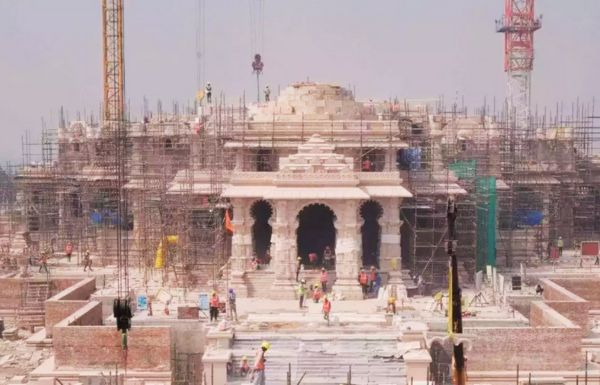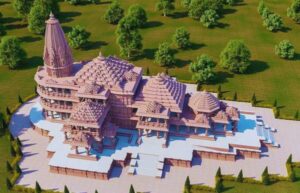
In the heart of Ayodhya, a city that resonates with spiritual significance for millions of Indians, lies a tale that intertwines religion, history, and politics—the story of the Ram Mandir and Babri Masjid. This contentious issue has been a focal point of national discourse, evoking strong emotions and sparking debates on communal harmony and religious tolerance.
Historical Background
The roots of the Ram Mandir-Babri Masjid dispute date back to the 16th century when the Babri Masjid was built in Ayodhya by Mughal Emperor Babur. Hindus believe that the mosque was constructed on the birthplace of Lord Ram, one of the most revered deities in Hinduism. The dispute gained prominence in the 20th century, fueling tensions between the Hindu and Muslim communities.
Legal Battles
The legal battle over the site commenced in the 19th century, with various court cases filed by both communities. The intensity of the conflict heightened in 1992 when a large gathering of Hindu activists demolished the Babri Masjid, claiming it was a symbolic act to reclaim the birthplace of Lord Ram. This event led to nationwide uproar, communal riots, and a prolonged legal battle.
Ayodhya Verdict
In November 2019, the Supreme Court of India delivered a historic verdict on the Ayodhya land dispute. The court ruled in favor of the construction of a Ram Mandir at the disputed site, while also directing the government to allocate an alternate piece of land for the construction of a mosque. The verdict aimed to bring closure to a decades-long dispute and foster communal harmony.
Ram Mandir Construction
Following the verdict, the construction of the Ram Mandir began, symbolizing the fulfillment of a long-standing demand of the Hindu community. The project garnered support from various quarters, while others expressed concerns about the potential impact on religious harmony.
Reconciliation and Communal Harmony
The construction of the Ram Mandir and the allocation of land for the mosque marked a significant step towards reconciliation. Leaders from both communities emphasized the need for unity and harmony, urging people to look beyond the historical discord and build a future based on mutual respect.
The Iconic Ram Temple in Ayodhya: A Marvel of Traditional Heritage and Modern Engineering
In the heart of Ayodhya, the grand temple dedicated to Ram Lalla, the divine child form of Lord Ram, stands as a testament to the seamless fusion of traditional Indian heritage architecture and cutting-edge science. Spearheaded by the Shri Ram Janmabhoomi Teerth Kshetra Trust, the construction of this monumental structure has been a collaborative effort involving top Indian scientists and even incorporating technology from the Indian Space Research Organisation (ISRO).

The architectural vision behind the temple draws inspiration from the Nagar Shaily, representing the traditional northern Indian temple designs. Chandrakant Sompura, a seasoned architect with a lineage spanning 15 generations, crafted the design, ensuring that the Ram Temple emerges as a rarely seen and uniquely splendid creation on a global scale.
Spanning 2.7 acres with a built-up area of 57,000 square feet, the three-floor structure stands at a height of 161 feet, approximately 70% of the Qutab Minar’s height. Notably, the construction avoids the use of iron or steel, opting for the enduring qualities of granite, sandstone, and marble. Dr. Pradeep Kumar Ramancharla, Director of the Central Building Research Institute, emphasizes the use of a lock-and-key mechanism instead of cement or lime mortar in joints, ensuring longevity.
The structural design of the temple, comprising three floors, is engineered to withstand earthquakes with a return period of 2,500 years. A meticulous analysis revealed a sandy and unstable ground below the temple due to the proximity of the Sarayu River. To counter this challenge, an innovative solution involved excavating the soil to a depth of 15 meters. An engineered soil layer was laid, followed by a 1.5-meter thick metal-free concrete raft for reinforcement. A 6.3-meter thick plinth of solid granite from southern India further strengthened the foundation.

The visible part of the temple, made from ‘Bansi Paharpur’ pink sandstone from Rajasthan, boasts a meticulous design featuring 160 columns on the ground floor, 132 on the first floor, and 74 on the second floor. The sanctum sanctorum is adorned with white makrana marble from Rajasthan, reminiscent of the material used in the construction of the Taj Mahal.
The Central Building Research Institute has played a crucial role in the project, contributing to the structural design, ‘Surya Tilak’ mechanism design, foundation vetting, and structural health monitoring of the main temple. Dr. Sharda Srinivasan, an archaeologist, notes the temple’s adherence to traditional dry masonry techniques, emphasizing interlocking grooves and pegs in place of mortar and iron.
Ramancharla underscores the incorporation of modern finite element analysis, sophisticated software tools, and 21st-century building codes in defining the Ram Temple. Confident in its robust construction, he asserts that the temple, rooted in heritage architecture, is equipped to endure for more than a thousand years. The construction of the Ram Temple stands not only as a remarkable architectural achievement but also as a harmonious blend of tradition and innovation, ensuring its longevity for generations to come.
Conclusion
The Ram Mandir-Babri Masjid issue reflects the complex interplay of history, religion, and politics in India. The journey from the construction of the Babri Masjid to the resolution of the dispute through a legal verdict and subsequent construction of the Ram Mandir is a testament to the resilience of India’s pluralistic society. As the nation moves forward, it is crucial to emphasize the importance of communal harmony, understanding, and respect for diverse religious beliefs, fostering an environment where all communities can coexist peacefully.
A big thank you for exploring Techlesnar.com! Your visit means a lot to us, and we’re grateful for your time on our platform. If you have any feedback or suggestions, we’d love to hear them. Looking forward to serving you again soon!
Leave a Reply